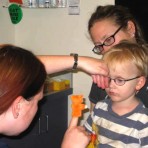Questions asked at our initial visit surprised me, as they regarded school frustrations and attention issues, as well as what I’d thought of as the “normal” eye-related physical questions. Dr. Ruggiero has also provided strategies for success at school.
Hyperactive. Dyslexic. ADHD. Defiant.
 These labels are frequently used by parents and teachers when children are seen struggling in school. Some students have trouble concentrating, while others are easily distracted and seem to fidget endlessly. Still others seem to have reading and comprehension difficulties that are causing them to fall behind their peers.
These labels are frequently used by parents and teachers when children are seen struggling in school. Some students have trouble concentrating, while others are easily distracted and seem to fidget endlessly. Still others seem to have reading and comprehension difficulties that are causing them to fall behind their peers.
But while their symptoms may vary, for many of these children, the root cause is the same – an undiagnosed vision disorder.
According to the American Foundation for Vision Awareness, approximately 17 to 25 percent of school-age children have vision problems significant enough to impact their performance in school. For children with diagnosed learning or behavioral problems, this rate may be as high as 60 percent.
Why Vision Problems Go Undetected
 While almost all children have their clarity of sight evaluated at least once by a pediatrician or school nurse, these tests generally only utilize the basic Snellen eye chart for 20/20 vision. But while this test is effective in determining a child’s visual acuity (how clearly they see) at a distance, it cannot detect problems with near vision, eye teaming, focusing, depth perception, visual perception or visual information processing – all of which can cause significant problems in school.
While almost all children have their clarity of sight evaluated at least once by a pediatrician or school nurse, these tests generally only utilize the basic Snellen eye chart for 20/20 vision. But while this test is effective in determining a child’s visual acuity (how clearly they see) at a distance, it cannot detect problems with near vision, eye teaming, focusing, depth perception, visual perception or visual information processing – all of which can cause significant problems in school.
This perception of “good eyesight” has a profound effect: In an evaluation of visual efficiencies among lower elementary students, vision problems were found to be the primary cause of reading failure among students. Furthermore, the school vision screenings most frequently utilized were ineffective in detecting these problems.
Even vision tests given by other eye doctors often fail to detect many vision problems, as only developmental/behavioral optometrists routinely test for visual efficiency or processing dysfunctions.
Does My Child Have a Vision Problem?
Given the prevalence of vision disorders, we recommend that all children receive a comprehensive vision examination by a developmental/behavioral optometrist to look at their eye tracking, convergence, depth perception, focusing, and visual processing. This is particularly important if your child has been diagnosed with ADHD, autism, hyperactivity or another learning or behavioral disorder, as a full visual evaluation will detect any underlying vision problems that are causing or contributing to the diagnosis.
Some common symptoms that may indicate an undiagnosed vision problem in your child include: poor reading comprehension, frequent eye rubbing, distractibility, a short attention span, lack of concentration, irritable, low-self esteem and anxiety. You’ll find a full checklist of symptoms here.
